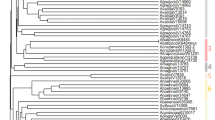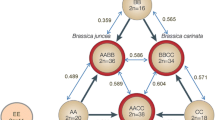Abstract
The cultivated peanut (Arachis hypogaea L.) is an allotetraploid, with two types of genomes, classified as AA and BB, according to cytogenetic characters. Similar genomes to those of A. hypogaea are found in the wild diploid species of section Arachis, which is one of the nine Arachis sections. The wild species have resistances to pests and diseases that affect the cultivated peanut and are a potential source of genes to increase the resistance levels in peanut. The aim of this study was to analyze the genetic variability within AA and BB genome species and to evaluate how they are related to each other and to A. hypogaea, using RAPD markers. Eighty-seven polymorphic bands amplified by ten 10-mer primers were analyzed. The species were divided into two major groups, and the AA and the BB genome species were, in general, separated from each other. The results showed that high variation is available within species that have genomes similar to the AA and the BB genomes of A. hypogaea.

Similar content being viewed by others
References
Bechara MD (2001) Relações filogenéticas no gênero Arachis, utilizando espaçadores transcritos internos (ITS) de rDNA nuclear. PhD Thesis, Universidade Estadual Paulista (UNESP), Botucatu
Fernández A, Krapovickas A (1994) Cromosomas y evolución en Arachis (Leguminosae). Bonplandia 8:187–220
Ferreira ME, Grattapaglia D (1998) Introdução ao uso de marcadores moleculares em análise genética. EMBRAPA-CENARGEN, Brasília, pp 220
Garcia GM, Stalker HT, Kochert G (1995) Introgression analysis of an interspecific hybrid population in peanuts (A. hypogaea) using RFLP and RAPD markers. Genome 39:166–176
Garcia GM, Stalker HT, Shroeder E, Kochert G (1996) Identification of RAPD, SCAR and RFLP markers tightly linked to nematode resistance genes introgressed from A. cardenasii to A. hypogaea. Genome 39:836–845
Gimenes MA, Lopes CR, Valls JFM (2002) AFLP analysis of genetic relationships among. Arachis species. Genet Mol Biol 25:349–353
Hilu KW, Stalker HT (1995) Genetic relationships between peanut and wild species of Arachis sect. Arachis (Fabaceae): evidence from RAPDs. Plant Syst Evol 198:167–178
Holbrook CC, Stalker HT (2003) Peanut breeding and genetic resources. In: Janick J (ed) Plant breeding reviews. John Wiles & Sons Inc., Hoboken, pp 297–356
Kochert G, Halward T, Branch WD, Simpson CE (1991) RFLP variability in peanut (Arachis hypogaea L.) cultivars and wild species. Theor Appl Genet 81:565–570
Kochert G, Stalker HT, Gimenes M, Galgaro L, Lopes CR, Moore K (1996) RFLP and cytogenetic evidence on the origin and evolution of allotetraploid domesticated peanut Arachis hypogaea (Leguminosae). Am J Bot 83:1282–1291
Krapovickas A, Fernández A, Seeligman P (1974) Recuperacion de la fertilidad en un hibrido interspecifico esteril de Arachis (Leguminosae). Bonplandia 8:1–186
Krapovickas A, Gregory WC (1994) Taxonomia del genero Arachis (Leguminosae). Bonplandia 8:1–186
Lanham PG, Foster BP, McNicol P, Moss JP, Powell W (1994) Seed storage protein variation in Arachis species. Genome 37:487–496
Lu J, Pickersgill B (1993) Isozyme variation and species relationships in peanut and its wild relatives (Arachis L. - Leguminosae). Theor Appl Genet 85:550–560
Mallikarjuna N, Pande S, Jadhav DR, Sastri DC, Rao JN (2004) Introgression of disease resistance genes from Arachis kempff-mercadoi into cultivated groundnut. Plant Breed 123:573–576
Moretzsohn MC, Hopkins MS, Mitchell SE, Kresovich S, Valls JFM, Ferreira ME (2004) Genetic diversity of peanut (Arachis hypogaea L.) and its wild relatives based on the analysis of hypervariable regions of the genome. BMC Plant Biol 4:11
Nei M, Li W-H (1979) Mathematical model for studying genetic variation in terms of restriction endonucleases. Proc Natl Acad Sci USA 76:5269–5273
Pande S, Rao NJ (2001) Resistance of wild Arachis species to late leaf spot and rust in greenhouse trials. Plant Dis 85:851–855
Pickersgill B (1986) Evolution of hierarchical variation patterns under domestication and their taxonomic treatment. In: Styles BT (ed) Infraspecific classification of wild and cultivated plants. Clarendon Press, Oxford, pp 191–209
Seijo JG, Lavia GI, Fernández A, Krapovickas A, Ducasse D, Moscone EA (2004) Physical mapping of the 5s and 18s–25s rRNA genes by FISH as evidence that Arachis duranensis and A. ipaënsis are the wild diploid progenitors of A. hypogaea (Leguminosae). Am J Bot 91:1294–1303
Singh AK, Moss JP (1984) Utilization of wild relatives in the genetic improvement of Arachis hypogaea L. 5. Genome analysis in section Arachis and its implications in gene transfer. Theor Appl Genet 68:355–364
Smartt J, Gregory WC (1967) Interspecific cross-compatibility between the cultivated peanut Arachis hypogaea and members of the genus Arachis. Oléagineux 22:455–459
Stalker HT (1991) A new species in section Arachis of peanuts with a D genome. Am J Bot 78:630–637
Stalker HT, Beute MK (1993) Registration of four interspecific peanut germplasm lines resistant to Cercospora arachidicola. Crop Sci 33:1117
Stalker HT, Campbell WV (1983) Resistance of wild species of peanuts to an insect complex. Peanut Sci 10:30–33
Stalker HT, Dhesi JS, Parry D, Hahn J (1991) Cytological and interfertility relationships of Arachis section Arachis. Am J Bot 78:238–246
Tallury SP, Hilu KW, Milla SR, Friend SA, Alsaghir M, Stalker HT, Quandt D (2005) Genomic affinities in Arachis section Arachis (Fabaceae): molecular and cytogenetic evidence. Theor Appl Genet 111:1229–1237
Valls JFM, Simpson CE (2005) New species of Arachis L. (Leguminosae) from Brazil, Paraguay and Bolivia. Bonplandia 14:35–64
Van der Peer Y, De Watcher R (1994) TREECON for Windows: a software package for the construction and drawing of evolutionary trees for the microsoft windows environment. Comput Appl Biosci 10:569–570
Young ND, Weeden NF, Kochert G (1996) Genome mapping in legumes (Family Fabaceae). In: Paterson AH (ed) Genome mapping in plants. Landes, pp 211–277
Acknowledgments
We thank Dr. José F.M. Valls for the valuable contribution and supply plant material. This work was supported by Fundação de Amparo a Pesquisa do Estado de São Paulo (FAPESP).
Author information
Authors and Affiliations
Corresponding author
Rights and permissions
About this article
Cite this article
da Cunha, F.B., Nobile, P.M., Hoshino, A.A. et al. Genetic relationships among Arachis hypogaea L. (AABB) and diploid Arachis species with AA and BB genomes. Genet Resour Crop Evol 55, 15–20 (2008). https://doi.org/10.1007/s10722-007-9209-6
Received:
Accepted:
Published:
Issue Date:
DOI: https://doi.org/10.1007/s10722-007-9209-6




